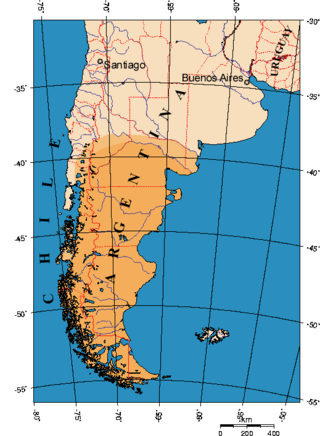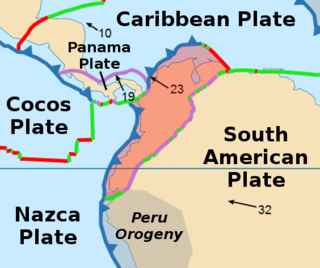
The Andes, Andes Mountains or Andean Mountain Range are the longest continental mountain range in the world, forming a continuous highland along the western edge of South America. The range is 8,900 km (5,530 mi) long, 200 to 700 km wide, and has an average height of about 4,000 m (13,123 ft). The Andes extend from north to south through seven South American countries: Venezuela, Colombia, Ecuador, Peru, Bolivia, Chile and Argentina.

Patagonia is a geographical region that encompasses the southern end of South America, governed by Argentina and Chile. The region comprises the southern section of the Andes Mountains with lakes, fjords, temperate rainforests, and glaciers in the west and deserts, tablelands and steppes to the east. Patagonia is bounded by the Pacific Ocean on the west, the Atlantic Ocean to the east, and many bodies of water that connect them, such as the Strait of Magellan, the Beagle Channel, and the Drake Passage to the south.

The Strait of Magellan, also called the Straits of Magellan, is a navigable sea route in southern Chile separating mainland South America to the north and Tierra del Fuego to the south. The strait is considered the most important natural passage between the Atlantic and Pacific oceans. It was navigated by canoe-faring indigenous peoples including the Kawésqar for thousands of years. In 1520, the Spanish expedition of Ferdinand Magellan, after whom the strait is named, became the first Europeans to discover it.

The Köppen climate classification is one of the most widely used climate classification systems. It was first published by German-Russian climatologist Wladimir Köppen (1846–1940) in 1884, with several later modifications by Köppen, notably in 1918 and 1936. Later, German climatologist Rudolf Geiger (1894–1981) introduced some changes to the classification system, which is thus sometimes called the Köppen–Geiger climate classification.

Maguindanao, Maguindanaon or Magindanao is an Austronesian language spoken by a majority of the population of Maguindanao del Norte and Maguindanao del Sur in the Philippines. It is also spoken by sizable minorities in different parts of Mindanao such as the cities of Zamboanga, Davao, and General Santos, and the provinces of North Cotabato, Sultan Kudarat, South Cotabato, Sarangani, Zamboanga del Sur, Zamboanga Sibugay, as well as Metro Manila. This was the language of the historic Sultanate of Maguindanao (1520–1905), which existed before and during the Spanish colonial period from 1565 to 1898.

Leopardus is a genus comprising eight species of small cats native to the Americas. This genus is considered the oldest branch of a genetic lineage of small cats in the Americas whose common ancestor crossed the Bering land bridge from Asia to North America in the late Miocene.

South American native ungulates, commonly abbreviated as SANUs, are extinct ungulate-like mammals of controversial affinities that were indigenous to South America prior to the Great American Biotic Interchange. They comprise five major groups conventionally ranked as orders—Astrapotheria, Litopterna, Notoungulata, Pyrotheria, and Xenungulata—as well as the primitive "condylarth" groups Didolodontidae and Kollpaniinae. It has been proposed that some or all of the members of this group form a clade, named Meridiungulata, though the relationships of South American ungulates remain largely unresolved. The two largest groups of South American ungulates, the notoungulates and the litopterns, were the only groups to persist beyond the mid Miocene. Only a few of the largest species of notoungulates and litopterns survived until the end-Pleistocene extinctions.

Trigonostylops is an extinct genus of South American meridiungulatan ungulate, from the Late Paleocene to Late Eocene of South America and Antarctica. It is the only member of the family Trigonostylopidae.
The Brazil national under-20 football team, also known as Brazil Sub-20 or Seleção Sub-20, represents Brazil in association football at this age level and is controlled by the Brazilian Football Confederation (CBF).

The Mutisioideae are a subfamily in the plant family Asteraceae that includes about 630 species assigned to 44 different genera. This subfamily is mainly native in South America, except for Adenocaulon, Chaptalia, Gerbera, Trichocline, which have species in all continents other than Europe and Antarctica. Common characters are the deeply incised corollas of the disc florets, with five lobes, sometimes merged in two lips, flower heads with overlapping involucral bracts, anthers with tails and pointy tips, the styles usually stick far out of the florets and are essentially hairless. Most species are herbs, but some are vines, shrubs, or small trees.

Calenduleae is a flowering plant tribe of the family Asteraceae. Calenduleae has been widely recognized since Alexandre de Cassini in the early 19th century. There are eight genera and over 110 species, mostly found in South Africa.

Enteroctopus megalocyathus, also known as Patagonian red octopus (EN), Pulpo del sur (Chile) and Pulpo colorado (Argentina); is a medium-sized octopus, and the type species for the genus Enteroctopus.

The climate of Argentina varies from region to region, as the vast size of the country and wide variation in altitude make for a wide range of climate types. Summers are the warmest and wettest season in most of Argentina except in most of Patagonia where it is the driest season. Warm in the north, cool in the center and cold in the southern parts experiencing frequent frost and snow. Because southern parts of the country are moderated by the surrounding oceans, the cold is less intense and prolonged than areas at similar latitudes in the northern hemisphere. Spring and autumn are transition seasons that generally feature mild weather.

The North Andes Plate or North Andes Block is a small tectonic plate (microplate) located in the northern Andes. It is squeezed between the faster moving South American Plate and the Nazca Plate to the southwest. Due to the subduction of the Malpelo and Coiba Plates, this area is very prone to volcanic and seismic activity, with many historic earthquakes.

Wei-Assipu-tepui, also known as Little Roraima or Roraimita, is a minor tepui of the Eastern Tepuis chain. It lies just off the northeastern flank of Roraima-tepui, directly on the border between Brazil and the disputed Guayana Esequiba territory, claimed by Venezuela but controlled by Guyana, and very close to the tripoint of all three countries. The mountain is known for its extensive cave systems, with one extending for over a kilometre.
The 1971 Campeonato Argentino de Rugby was won by the selection of Unión de Rugby de Buenos Aires that beat in the final the selection of Unión de Rugby de Rosario
The 1961 Campeonato Argentino de Rugby was won by Mar del Plata who defeated Rosario in the final. There were several changes in this tournament:
The Campeonato Argentino de Rugby 1964 was won by the selection of Buenos Aires that beat in the final the selection of Rosario

Sara Sara is a 5,505-metre-high (18,061 ft) volcano lying between Lake Parinacochas and the Ocoña River in Peru. It is situated in the Parinacochas Province and the Paucar del Sara Sara Province. The volcano formed during the Pleistocene during four different stages of volcanic activity, which constructed a volcanic edifice with an oval outline consisting of lava flows and lava domes. The volcano was glaciated during the last glacial maximum; it may still feature glaciers. The last eruption was about 14,000 years ago and future eruptions are possible. The volcano was worshipped by the local population, and an Inca mummy of a 15-year old girl was found on the summit by archaeologists.

Luis Enrique Vidal Gimó was a Chilean footballer who played as a centre back.















